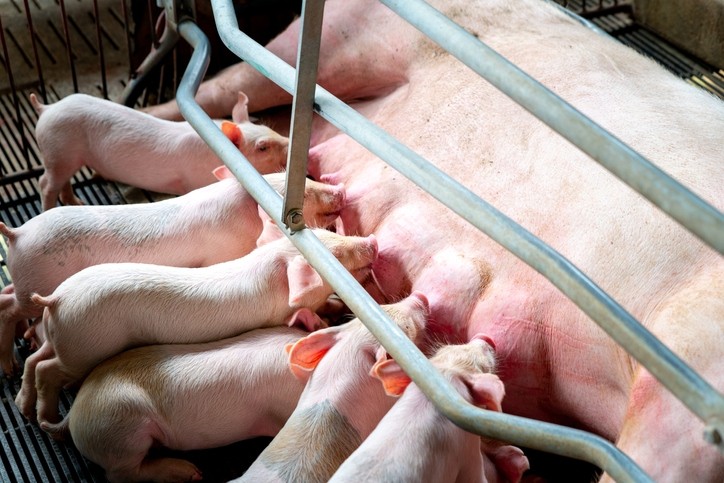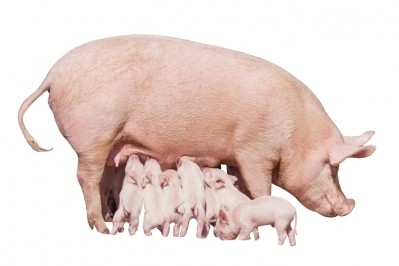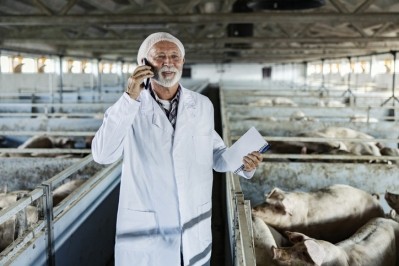Sow precision feeding strategy sees reduced costs and environmental gains

The environmental load also decreased with such a dietary approach, said the team behind the study, which was published in Animal Feed Science and Technology.
The researchers, who are based at the French national research institute, INRAE, saw that reproductive performance was not affected by precision feeding, and neither was feeding behavior.
New feeding strategies needed
Gestating sows are often fed with the same standard diet during their gestation even though their nutrient requirements vary during gestation and among sows. Only feed allowance is sometimes adjusted regarding the parity, gestation stage, and body condition (Young et al., 2004), reported the authors.
“In all cases, this group feeding strategy leads to protein and minerals under- or over-feeding situations which may result in a lack of performance and health issues on the one hand, and economic loss and environmental negative effects on the other.
“To reduce environmental load and feed costs, new feeding strategies have been developed in pig production (Dourmad et al., 2015, Andretta et al., 2016). Combined with improved nutritional models, smart feeders are now able to offer a daily amino acid (AA)-adjusted ration to each animal regarding its nutrient requirements.”
Study goals
Using a simulation approach based on farm databases, the researchers said they evaluated the potential of such a precision feeding (PF) strategy for gestating sows (individual and daily mixing of two diets with different AA content) compared to a conventional feeding (CF) strategy (a single diet with a fixed AA content).
Simulations indicated that PF appeared to be relevant to better meet the AA requirement and that, compared to a CF strategy, it reduced feed costs by 3.6%, lysine intake by 30%, and nitrogen and phosphorus excretion by 17% and 15%, respectively (Gaillard et al., 2020).
However, those results were not been validated in a farm-based experimentally. Moreover, they did not allow for analysis of precision feeding on reproductive performance or feeding behaviors, said the INRAE team.
So their recent study was aimed at comparing the effect of a PF strategy on productive and reproductive performances of gestating sows compared to a CF approach, while also evaluating the impact of a PF strategy on sows’ feeding behavior, in terms of frequency of visits and time spent in the feeder.
The methodology
The experiment included 131 gestating sows divided into the two feeding strategies regarding their parity and body weight at insemination.
As lysine is the first limiting AA in plant-based diets for sows, the researchers said the two feeding strategies were based on the mixture of two diets with different standardized ileal digestible lysine (SID Lys) concentrations: a diet with a high lysine content (H diet, with 8.5 g SID Lys/kg of feed) and a diet with a low lysine content (L diet, with 3.3 g of SID Lys/kg of feed).
For the CF strategy, they said the sows received a fixed mixture of the L and H diets (73% and 27%, respectively) during all the gestation, so a mixture with a fixed lysine content of 4.7 g SID Lys/kg of feed.
For the PF strategy, the sows received an individualized mixture of L and H diets, varying over the gestation, according to their requirements.
Calculations of individual feed allowance for all sows and diets proportions for the PF sows were done with the InraPorc model, which calculates the requirement estimates in energy, AA, and minerals of each animal and then determines the ration’s quantity and composition to be distributed, they added.
Such calculations take into account individual characteristics like sow’s age, maternal body weight (BW) and backfat thickness (BT) at insemination as well as their targets at farrowing.
Findings
The results matched those from earlier simulations the team had run, as sows fed the PF strategy reduced their lysine ingestion of around 25%, which therefore reduced nitrogen excretion of 18.5%, and feed costs by €3 to €4 per gestation or €8 (US$8.43) per ton of feed.
Phosphorus intake and excretion were also reduced with PF compared to CF, around 8% and 9%, respectively.
Reproductive performance, defined as the number of piglets per litter and the litter weight, was not affected by the feeding strategy.
Time spent at the feeder for feeding visits or non-feeding visits was constant over the gestation for the CF sows while for the PF sows it increased over gestation.
“Compared to the CF strategy, the PF strategy reduced lysine intake, nitrogen excretion, phosphorus excretion, and feed costs per gestation of around 25%, 18.5%, 9%, and 3.7%, respectively. Reproductive performance and sow’s body characteristics were not affected by the feeding strategy. The number of feeding visits to the feeder and the time spent for these visits were barely affected by feeding strategy. Only at the end of the gestation the frequency of non-feeding visits and the time spent in the feeder were higher for the PF sows compared to the CF sows. In conclusion, the PF strategy reduced lysine intake, protein intake and feed costs without influencing reproductive performance while reducing nitrogen and phosphorus excretion.”








